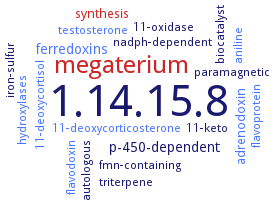1.14.15.8: steroid 15beta-monooxygenase
This is an abbreviated version!
For detailed information about steroid 15beta-monooxygenase, go to the full flat file.

Word Map on EC 1.14.15.8 
-
1.14.15.8
-
megaterium
-
p-450-dependent
-
ferredoxins
-
synthesis
-
adrenodoxin
-
autologous
-
triterpene
-
11-oxidase
-
testosterone
-
flavodoxin
-
flavoprotein
-
hydroxylases
-
aniline
-
11-deoxycortisol
-
nadph-dependent
-
fmn-containing
-
paramagnetic
-
iron-sulfur
-
biocatalyst
-
11-keto
-
11-deoxycorticosterone
- 1.14.15.8
- megaterium
-
p-450-dependent
- ferredoxins
- synthesis
- adrenodoxin
-
autologous
-
triterpene
-
11-oxidase
- testosterone
- flavodoxin
- flavoprotein
- hydroxylases
- aniline
- 11-deoxycortisol
-
nadph-dependent
-
fmn-containing
-
paramagnetic
-
iron-sulfur
-
biocatalyst
-
11-keto
- 11-deoxycorticosterone
Reaction
Synonyms
15beta-hydroxylase, 15beta-hydroxylase CYP106A2, BmCYP106A2, Cyp106A1, CYP106A2, cytochrome P-450meg, cytochrome P450meg, steroid-15-beta-monooxygenase
ECTree
Advanced search results
Cloned
Cloned on EC 1.14.15.8 - steroid 15beta-monooxygenase
Please wait a moment until all data is loaded. This message will disappear when all data is loaded.
a steroid 15beta-hydroxylating whole-cell solvent tolerant biocatalyst is constructed by expressing the Bacillus megaterium steroid hydroxylase CYP106A2 in the solvent tolerant Pseudomonas putida S12
-
CYP106A2 can be easily expressed in Escherichia coli with a high yield and can be reconstituted using the adrenal redox proteins, adrenodoxin and adrenodoxin reductase
expressed in Escherichia coli and Bacillus subtilis. No hydroxylation is found with protein extracts from recombinant Escherichia coli strains since cytochrome P450meg needs additional electron transfer proteins for enzymatic activity, which are missing in Escherichia coli. Bacillus subtilis, in contrast to Escherichia coli, contains an electron transfer system capable of supporting the activity of cytochrome P450meg
expression in Escherichia coli
expression in Escherichia coli, wild type and mutant S72A/V73I, the DELTA72 mutant, which lacks the first 72 amino acids, is not expressed in Escherichia coli at a detectable amount, suggesting that the truncated mutant cannot fold properly within the bacterial cell
expression of the enzyme together with the electron-transfer partners bovine adrenodoxin and adrenodoxin reductase in Escherichia coli. Additionally an enzyme-coupled cofactor regeneration system was implemented by expressing alcohol dehydrogenase from Lactobacillus brevis. By studying the conversion of progesterone and testosterone, the bottlenecks of these P450-catalyzed hydroxylations are identified. Substrate transport into the cell and substrate solubility turned out to be crucial for the overall performance. Based on these investigations a new concept for CYP106A2-catalyzed steroid hydroxylations is developed by which the productivity of progesterone and testosterone conversion could be increased up to 18fold to yield an absolute productivity up to 5.5 g/L*d
functional expression of CYP106A2 in Escherichia coli strain BL21 from plasmid pET-CYP13 on the outer membrane with exposure on the surface without the external addition of the heme group but absolutely requiring the coexpression of TolC channel protein JW5503, because Escherichia coli uses a TolC-dependent mechanism to export heme into the growth media, where it can be scavenged by a surface-displayed apoenzyme
-
recombinant expression of CYP106A2 by protoplast transformation is only successfully in the plasmid-less Bacillus megaterium strain MS941, not in strain ATCC 13368, coexpression of heterologous redox chain of the P450, bovine adrenodoxin reductase, and bovine adrenodoxin
-


 results (
results ( results (
results ( top
top





